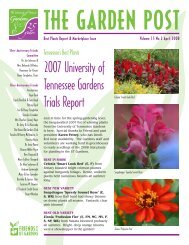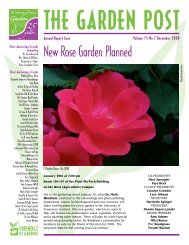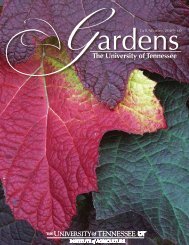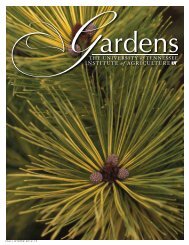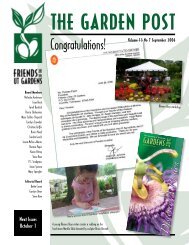May - UT Gardens - The University of Tennessee
May - UT Gardens - The University of Tennessee
May - UT Gardens - The University of Tennessee
You also want an ePaper? Increase the reach of your titles
YUMPU automatically turns print PDFs into web optimized ePapers that Google loves.
Botanical Name: Cornus kousaCommon Name: Kousa DogwoodWe all enjoyed the show that the FloweringDogwood (Cornus florida) gave us in late Marchand early April. This month its cousin from Asiatakes its turn flowering. While Cornus kousa is thescientific name, it is commonly referred to as theKousa Dogwood.Native to Japan, China and Korea, C. kousa wasintroduced into cultivation in 1875. <strong>The</strong> leaves<strong>of</strong> C. kousa are smaller than those <strong>of</strong> our nativeC. florida, and the branches have a more horizontalpattern to them. This species makes a greatspecimen tree or an addition to a shrub border toadd some height and again display the horizontalbranching. One <strong>of</strong> the most notable characteristics<strong>of</strong> C. kousa is its bark. Tan, gray and brownall can be found in the bark <strong>of</strong> the trunk and thestems. Bark is exfoliating with age and producesgreat color patterns. This adds to its winter appealmaking this a four-season show plant in the garden.<strong>The</strong> flowers <strong>of</strong> C. kousa are slightly smaller thanthose <strong>of</strong> C. florida and appear weeks after thosemore familiar trees have bloomed. C. kousa flowersmid-<strong>May</strong> in our area, sometimes lasting into June.<strong>The</strong> fact that they flower during this period is nice,because the leaves have broken dormancy and theflowers show up very nicely elevated above the darkgreen leaves.<strong>The</strong> tree can rise 20-30’ but is slow growing, andmulti-stemmed shrubs can also be formed. <strong>The</strong>largest <strong>of</strong> the species is C. kousa var. chinensis,which can reach the 30-foot mark and usuallydisplays slightly larger flowers. Many cultivars arewidely available locally, and one notable cultivar<strong>of</strong> this variety is ‘Milky Way.’ Michael Dirr describesthis cultivar in his Manual <strong>of</strong> Woody OrnamentalPlants as “appearing more floriferous than thespecies.” <strong>The</strong> <strong>UT</strong> <strong>Gardens</strong> has another beautifulcultivar, ‘Wolf Eyes,’ which is a variegated selection.Variegated dogwoods can burn in the sun, but thisCornus kousa ‘Wolf Eyes’cultivar seems to do just fine in partial shade. <strong>The</strong>reare also pink as well as white blooming cultivars.‘Wolf Eyes’ and the species specimen can both befound in the lower section <strong>of</strong> the woody gardenrooms. Another C. kousa is in the middle gardenroom on the path leading to the bridge to theChildren’s Touchstone Table and is near the Cornusmas or Cornelian Cherry past the Cornus florida.This provides a great opportunity to compare thesethree different species <strong>of</strong> dogwood.My favorite way to see this tree in the landscapeis in combination plantings <strong>of</strong> all three Cornusspecies mentioned. C. mas is the first to bloomin early March and is covered in clusters <strong>of</strong> yellowflowers. This is followed by our celebrated C. floridaand finally C. kousa, both <strong>of</strong> which bloom whiteor pink, making for a colorful show all spring. Besure not to miss the Cornus kousa while it’s in fullbloom; you might realize it’s just what your gardenis missing.—Robin Yeery10



